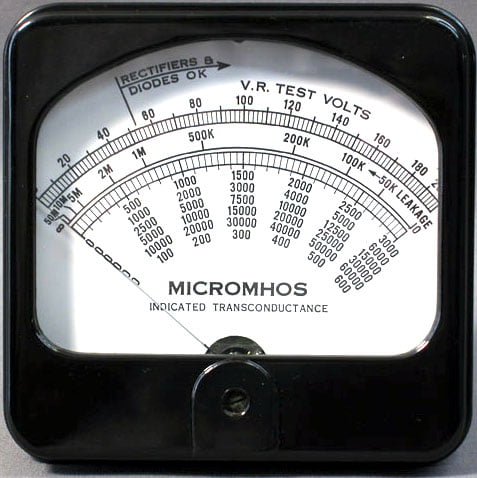
There is a lot of confusion about matching tubes. It starts with some vendors, especially on eBay, matching tubes by the way they look (visual matching) to matching on multiple electrical parameters at the same time.
There are 4 parameters that could be used to match preamp tubes:
- Transconductance – Gm
- Voltage Gain – Mu
- Plate Current – Ip
- Tube Age
Transconductance
Transconductance or Gm, measured in mhos (amps per voltage) and is defined as “the change in the plate(anode) current divided by the corresponding change in the grid/cathode voltage, with a constant plate(anode) to cathode voltage.” This is great! But not helpful to the majority of people 🙂 I’ll try to explain.
Most of the tubes are matched on that, and it works in most cases, especially for new tubes (but new tubes usually test great on Gm anyways). However, it’s not a great measure of real-life tube performance. But considering that the tube testers that measure Gm are easy to find and tubes are easy to test – this makes it a very popular choice. To get real-life performance, you would need also Plate resistance, but more on that below.
Since Gm has been used for decades to test tubes (which is mostly a marketing move by tube tester manufactures), most customers want the tubes to be matched on that and that’s exactly what dealers deliver.
Voltage Gain
This is measured as Mu and derived from Gm and Plate resistance (Mu = Gm x Rp). This is quite important since this defines how much (voltage or in many cases Volume gain will be achieved by a tube). There are super high-gain tubes with values like 110 Mu (Sovtek 12ax7WC), there are high-gain tubes, regular 12ax7 falls into it with gain up to 100, medium-gain tubes (e.g 12at7 – Mu 60), and low-gain tubes (e.g, 12au7 – Mu 20)
However, this is only based on specs – a real tube might not behave per-specs, especially if it’s a used tube. For example, I see a lot of tubes in 12au7 that don’t get to 20 Mu, but 17-16 (even new tubes). Not only that, but 12ax7 can measure 85 on one triode and 90 on the other triode (this includes new tubes) – this is around 5.5% difference.
Technically this is the most important measure of a triode tube, especially considering that most triodes are used as voltage amps; however, practically none of the tube testers (including very high-end tube tester like Hickok 539c) measure that. My Amplitrex sure doesn’t, but MaxiPreamp II does!
So you will rarely find tube listings that state that they match tubes based on Mu (gain), which is very unfortunate, but just reflects the reality. Technically, knowing Transconductance (Gm) should give you the gain, but it’s not the case – however, some people will argue that it’s close enough. I don’t think so. I have tubes that measure perfectly fine on transconductance (12ax7, 1746/1762 – awesome!, but gain is 82/96 for each triode) – now that’s 15% difference!
To make things worst, to reduce the anode voltage in power amps, a plate resistor is used which has its own variation in resistance vs spec (10% in most cases), so you can end up with a very noticeable difference in volume between channels.
Plate Current
Plate current (Ip) is just that, what “idle” current does a tube pass through and is the most important measure for Power tubes (particularly Pentodes). Most popular testers test Ip, but there is a major issue with Ip testing, practically none of the old school testers, test Ip at close to tube operating voltage, which ranges widely from 300v to 1200v (EL84 vs 211). For example, Hickok 539c measures tubes at 150v, which is very, very low. Tubes testers like MaxiMatcher and Amplitrex, test tubes at 400 and 500v respectively, which is much better (that’s what we use).
In other words, if tubes are not matched closer to the working conditions, they will not dissipate the same amount of power. This could lead to 2 problems: 1) if tubes are unmatched between channels, you will have different power between channels, 2) if tubes are unmatched in push-pull configuration, this will lead to distortion, as two parts of a sine wave will not match.
Most tube amps have bias settings to match the tubes, so what’s the big deal? Unfortunately, these bias resistors have limited range, so if you are lucky, you will be able to match un-matched tubes, but it’s not always possible. Some amps, unfortunately, don’t have a way to change bias at all, requiring a perfectly matched set.
Tube Age
Not really an electric parameter :), but worth considering. The best measure of a tube’s age is Gm, which does help a lot since a lot of tube testers test it. So if a tube is around 70% of spec, it’s very likely that it will be still matched if it was matched new. After that, the tube starts to degrade and parameters change, so it needs to be retested and re-matched.
The useful life of a tube ends when a tube reaches 50% of it’s Gm or Ip spec. For example, 12ax7 spec is 1700 Gm, so a value lower than 850 would mean that a tube is not good. Does it mean that it is unusable, not really, it’s likely to work, but at that point Gain and Noise change quite a lot – tubes start to become very noisy and the gain drops quite a bit.
Conclusion
This is not exhaustive by any means, but it will help you to be more informed when buying tubes. Please share your thoughts on the topic in the comments.

Great post! Thanks.
Thanks for a useful post will add comments and pictures on tube testing.